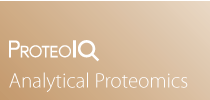References >> Lipidomics
LipidomicsLIPIDOMICS is an emerging field of biomedical research which includes complex lipidome analysis. Basically, a lipidome is the comprehensive and quantitative description of a set of lipid species present in an organism. Lipidomics involves systems-level identification and quantitation of thousands of pathways and networks of cellular lipids molecular species and their interactions with other lipids, proteins and other moieties in vivo.
Lipidomics itself is a subgroup within the field of metabolomics. Furthermore, lipidomics can be subdivided into:
-
Membrane-lipidomics: Includes the comprehensive and quantitative description of membrane lipid constituents.
-
Mediator-lipidomics: Includes the structural characterization and quantification of low abundant bioactive lipid species.
Lipids: The Essential Metabolites
Lipids are hydrophobic or amphipathic small molecules which include fats, waxes, sterols, fat-soluble vitamins (such as vitamins A, D, E and K), monoglycerides, diglycerides and phospholipids. The crucial role of lipids in a cell, tissue and organ physiology is evident by their unique membrane organizing properties that provide cells with functionally distinct subcellular
membrane compartments.
The main biological functions of lipids include:
-
Energy storage and structural components of cellular membranes.
-
Cell signaling (e.g. phospholipase C and phospholipase A2 in modulating immunological responses).
-
Endocrine actions (e.g. steroid hormones)
-
Essential role in signal transduction, membrane trafficking and morphogenesis.
Classification of Lipids
Lipids can be classified into 8 classes based on their chemical structure:
| 1. | Fatty Acyls [FA] | |
The fatty acyls are a diverse group of molecules synthesized by chain elongation of an acetyl-CoA primer with malonyl-CoA (or methylmalonyl-CoA) groups that may contain a cyclic functionality and/or are substituted with heteroatoms. Ex: Palmitic Acid |
 |
|
| 2. | Glycerolipids [GL] | |
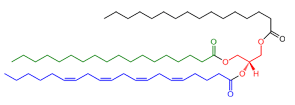 |
Glycerolipids are composed mainly of mono-, di- and tri-substituted glycerols, the most well-known being the fatty acid esters of glycerol (triacylglycerols), also known as triglycerides. Ex: 1-stearoyl-2-arachidonoyl-3-palmitoyl-triacylglycerol |
|
| 3. | Glycerophospholipids [GP] | |
Glycerophospholipids, also referred to as phospholipids, are key components of the lipid bilayers, as well as being involved in metabolism and signaling. Ex: Phosphatidylcholine |
 |
|
| 4. | Sphingolipids [SP] | |
 |
Sphingolipids are a complex family of compounds that contain a sphingoid base backbone and a long-chain fatty acyl-CoA, then converted into ceramides, phosphosphingolipids, glycosphingolipids, and other species, including protein adducts. Ex: N-palmitoyl-ceramide |
|
| 5. | Sterol Lipids [ST] | |
| Sterol lipids are an important component of membrane lipids along with the glycerophospholipids and sphingomyelins. These lipids mainly act as hormones and signaling molecules. Ex: Cholestrol |
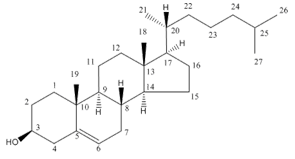 |
|
| 6. | Prenol Lipids [PR] | |
 |
Prenol lipids are synthesized from the 5-carbon precursors isopentenyl diphosphate and dimethylallyl diphosphate that are produced mainly via the mevalonic acid (MVA) pathway. Ex: 2E-geraniol |
|
| 7. | Saccharolipids [SL] | |
| Saccharolipids are those compounds in which fatty acids are linked directly to a sugar backbone, forming structures that are compatible with membrane bilayers. Ex: Kdo2-Lipid A |
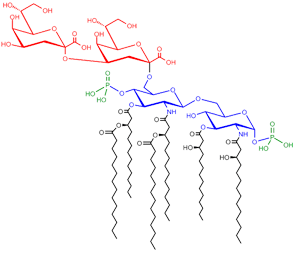 |
|
| 8. | Polyketides [PK] | |
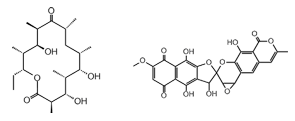 |
These comprise a very large number of secondary metabolites and natural products from animal, plant, bacterial, fungal and marine sources, and have great structural diversity. Many polyketides are cyclic molecules whose backbones are often further modified by glycosylation, methylation, hydroxylation, oxidation, and/or other processes. Ex: Griseorhodin A |
Mass Spectrometry Based Lipid Analysis
Many modern technologies (including mass spectrometry (MS), nuclear magnetic resonance (NMR), fluorescence spectroscopy, column chromatography, and microfluidic devices) are now being used in lipidomics to identify, quantify, and understand the structure and function of lipids in biological systems.
Improvements in mass spectrometric technology have proved highly efficient for the characterization and quantification of molecular lipid species in total lipid extracts. The main advantage of mass spectrometry is its ability to separate and characterize charged ionized analytes according to their mass-to-charge ratios (m/z). It can also provide structural information by fragmenting the lipid ions by collision-induced dissociation (CID). The various techniques used to record these fragmentation reactions are called tandem MS, or MS/MS or MSn. These attributes lead to unparalleled selectivity, sensitivity and the ability to provide structural information for components in complex mixtures.
The developed MS techniques can be mainly categorized into three groups:
-
Global Lipidomic Analysis: Identify and quantify hundreds to thousands of cellular lipid species via a high throughput basis. Different shotgun lipidomics-based platforms have been developed and extensively used to analyze diverse pathways and networks associated with lipid metabolism, trafficking, and homeostasis. Newly emerging mapping techniques play major roles in studying the spatial and temporal relationships of lipids.
-
Targeted Lipidomic Analysis: Identification of one or a few lipid classes of interest. LC-MS and LC-MS/MS based methods have been extensively utilized for this purpose.
-
Novel Lipid Discovery: Directed towards the discovery of novel lipid classes and molecular species. Methodology using LC coupled with MS plays an essential role in this area through different enrichment technologies.
Challenges for Lipidomics
Due to its specificity and complexity, lipidomics research is quite challenging, exciting, and unique. As opposed to genomics and proteomics, there is no information that can predict the number of individual lipid molecules present in an organism. Current technologies are therefore still unable to map lipidomes.
Moreover, the structural identification of lipids by mass spectrometry is complicated due to diverse lipid classes and lipid molecular species. It also becomes impossible to accommodate all lipid classes with a common method for extraction, chromatography and detection.
Lipid Identification and Characterization using SimLipid
SimLipid is an innovative lipid characterization tool. SimLipid analyzes lipid mass spectrometric data for characterizing and profiling lipids. SimLipid can annotate mass spectra with the lipid structures identified using abbreviations.
For details, please visit: www.premierbiosoft.com/lipid/index.html

